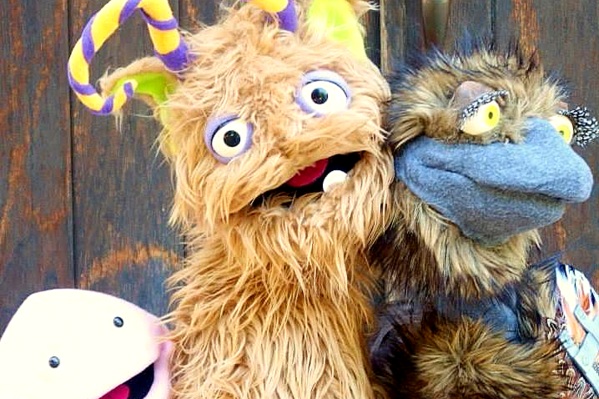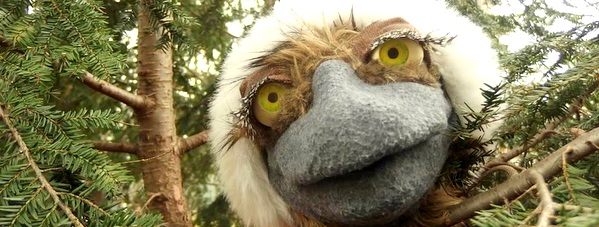Nicola Rose is a filmmaker, puppeteer and contributor on indieactivity. She writes on Puppetry
in Independent Film. Twitter | Instagram
Puppetry on film is by its nature an esoteric medium, allowing for all manner of comedy, tragedy and, most particularly, flights of fantasy. The web series How Do We Sing? combines all these and more. The brainchild of co-creators Jarod Facknitz and Erin Kathleen Flynn, this gently surreal web series tells the story of three eloquently silent hand puppets and their interactions with the world.
In this first installment of indieactivity series on puppetry in independent film, we spoke with Facknitz and Flynn about their unique series (viewable on Vimeo and YouTube) and how they arrived at their work.
Tell us about your background in puppetry
JF: I started out by keeping my stuffed animals on the bed for too long, then had the pleasure of spending a Summer instructed by Brad Lowe, who worked on the TV show Hot Fudge during the late 70s.
EF: In my last year at Northwestern, I met a group of folks that became the early grassroots of a very special puppet theater company in Chicago, Redmoon Theater. I was invited to hang around their tiny puppet studio in Logan Square and learn the art of paper mache, the craft of cardboard sculpture, and the magic of puppetry performance –giant puppetry, stilting, bunraku, shadow puppetry, lantern parades, and physical theater. Early on, I fell in love with the collaborative spirit of puppetry, a language so precise and poetic in its symbolic gesture, and an art devoid of ego. I worked, taught, and performed with this puppet theater for a total of six years. Since 1996, I’ve also been crafting my own live shows for children that involve object and puppetry work.
Which came first to you, puppetry or film? How did you end up combining the two?
EF: To me, I think the puppetry came first—together, we simply played with the dream of these characters that would explore the city; we brainstormed about a child’s endless questions, the tension between nature and the city, and creativity as survival. Initially, I know I was always just thinking about the puppets on these adventures in real time. It’s Jarod who knew how to create this on film. Jarod has this incredible vision for film in his eyes, ears and hands—an approach to drive the films with visual and musical arcs that push and pull with dramatic tensions that result in these gorgeous, heart-wrenching pictures. Jarod has this seemingly endless vision for film; a constant drive to shape the stories and a skill for making the ordinary extraordinary through framing, lighting, and staying open to creative choices. With each episode, Jarod is emboldened to try a new shot, a new poetry through the imagery, and to work without ego; he stays open to what the day brings and what the puppets offer. I think because the puppets are so dear to us, Jarod will always be exploring the next more challenging and spectacular, rule-breaking shot!
JF: I was raised on films that incorporated puppetry; the Muppets, Sheri Lewis, Soupy Sales, The Errand Boy with Jerry Lewis, Jan Svankmajer, and I love films by Herzog, Tarkovsky, Gilliam, the Coens, and Spike Lee among others, but their approach and technique are hardly ever found in anything intended for children (Gilliam’s Time Bandits is an exception).
It’s an exciting prospect to film these characters using earnest methods children’s entertainment avoids (black and white, slow zooms, long crossfades, natural lighting, and the utilization of our surroundings in a Dogme 95 vein).
What was the genesis of How Do We Sing? How about the title?
EF: I remember us listing all the questions that a child might dream, wonder, fear. I don’t remember the exact moment that we knew it would be How Do We Sing? but I know we were wanting this open-ended pondering that could provoke thoughts about how in this world do we survive, create, live, learn, grow, and…how do we find our voice? We found it could all be woven into this beautiful question – How Do We Sing?
JF: Children often explore broad-minded subject matter like: What happens when we die? What is God? Why do we dream? So we came up with story ideas to tackle these concerns. I remember hearing Crispin Glover encourage work that arouses questions instead of reassurances. This had a powerful effect on me. As a result, our title is a question that can be taken literally or rhetorically.
Tell us about the characters and how they evolved.
EF: Fantashtick was a character built on a child’s curiosity and brave, innocent need to adventure; Jarod imagined this character for many years, long before we met. I think for Harumph, we wanted a lovable, wise, big embrace of a monster. I think I drew him as very sweet and even silly, knowing he might be the leader of the three, but he became slow, careful, and much more introverted and spiritual than that initial drawing. He’s a big soul. Bellabird resulted because we wanted a bird in all of its natural instinct, faith, and music. She is a survivor, her wing mended, her heart on the outside. She is intuitive, protective; she listens carefully; and she sings for comfort, connection, survival, and change. I don’t think we always knew they’d be a family, but now, they most certainly are.
Your work is infused with curiosity about the world, as well abstract visual poetry and sometimes melancholy. In what ways do hand puppets express these things uniquely well?
JF: I had this experience on magic mushrooms where I concluded the greatest human undertaking is perpetual astonishment, rising above societal concerns through wonderment. Virtually every artist, scientist, and philosopher has done this in some form of another. Through astonishment, we stay open to possibility and avoid destructive tendencies. By extension, the characters in How Do We Sing? become a vessel onto which we can project any interpretation we like. Since our characters don’t speak, we’re left to consider their thoughts and reactions, which naturally become extensions of our personalities. Episode 6 tackles the question of a Higher Power. I talked to an atheist who concluded that the episode was saying God didn’t exist. I talked to a Christian who concluded we were confirming the existence of God. I find that fascinating.
EF: We think a lot about the eyes, as it’s important that the gaze is in the right, most effective focus. We think about how we can create gestures with the puppets that show a gentle and precise curiosity. We try to work with great care and subtlety and always stay as genuine and authentic as possible. As you might expect, we do lots and lots of takes and then we spend lots of time reviewing, and choosing the gesture that most tugs on our heartstrings, the one that seems most alive and authentic. We’ll review shots onsite to get a more precise posture and expression; then, we review again and choose the final shots in the editing process. Hand puppets, like all puppetry, are super challenging. In the moment, it’s technical, tiring, and sometimes painful. It can hardly feel like character work at all. It’s really hard work – pushing your own body to extend the puppet’s gesture to its most expressive place. It’s technique, technique, technique, until suddenly there’s magic. It’s so, so beautiful when that moment happens – when life fills the puppet and it’s expressive and true. And, I’m always so grateful, when I know Jarod has seen that moment through the lens. It’s a whole lot of work for that moment, and it often feels like a little magical gift, that has nothing to do with the hand or the puppeteer, and everything to do with the puppet.
Let’s talk about the contrast between your puppets and the backdrop of the “real” world around them. What inspires you about this juxtaposition?
JF: With puppets, the viewer makes a conscious choice to suspend disbelief, opening up to whatever follows. The characters of How Do We Sing? exist in the “real” world, but are either uninvolved or uninterested in humankind, which is beneficial because humankind tends to kill, eat, exploit, or dominate the unknown before making any attempts to understand. The lovely aspect about accepting a puppet and then being shown the world we already inhabit- not some idealized version but a world where death is imminent, God may not exist, the cities are filled with garbage and graffiti, and we’re forced to confront our insignificance- is that we have a new perspective on ourselves when watching Harumph react to a sign that looks like anti-rat propaganda, or Bellabird realizing discarded eggs in cartons never hatch, or Fantashtick realizing he’s in control of dreams and can overcome his nightmares. We see our flawed world through the eyes of creatures we’d prefer to protect, just like parents do with their children, and different aspects suddenly have a greater impact.
EF: To me, these creatures could be nowhere else but immersed in nature and the outdoors. To see the natural sunlight on these creatures, and to see them braving the ice and the cold. We always wanted the series to be in the real beauty that exists right in front of us, nothing fake or contrived. My favorite is to see the wind blowing through Bellabird’s feathers, or when we’re inspired by an extraordinary sound. Filming outside causes us to notice, to look again, to be improvisational and adaptive…just as these creatures must be.
How did you find each other, and do you have additional creative colleagues on the show? What are their roles?
EF: Just us, living, loving, dreaming, hoping, struggling through these creative challenges together. We found each other through our work as teaching artists and musicians and discovered that we both adored the language of puppetry. Because we love each other so truly, we can be vulnerable and child like in our creativity with each other. That’s rare and precious. The idea for the show and then the stories emerged rather organically and soon, we were working close with Bob’s Imaginary Friends to design the puppets. Jarod is the fiery one – the one with endless access to a muse, to his imagination, the one with the driving ambition to make an artistic impact. Once in it, I am always looking at the physical gesture of the puppetry and the little added bits that I can do to make their world artful, strange, and magical. I love creating the secret wonderful spaces where they live and love; and I truly love ensuring the language of the puppetry is the best it can be. When I’m lying in the icy snow or hiding in a wet hole in the sand or wedged between two rocks with a puppet on my arm, I’m in a very, very happy place.
JF: It’s often Erin and I, out and about getting laughs or strange looks from people. She handles the brunt of the puppetry, which is a joy to watch unfolding through the lens.
What are your thoughts on puppetry for an audience of children vs. an audience of adults? Or on the blending of the two?
JF: We keep everything to a PG rating, but seldom ever separate adults from children. Life is filled with complex challenges, so it makes sense to challenge children. By the same token, adults are looking for ways to nurture their inner child because it has a perspective worth holding sacred.
EF: For us, it’s just about making good puppetry and beautiful stories; and most of all, about our true love for these three creatures. Each episode, we get to know them more deeply. We’re not trying to write a hit story, contrive a laugh, or teach a lesson that will simply satisfy the parent of a child. And, we could never make a show that is “inappropriate” or excludes children because these three creatures just wouldn’t make such choices in this world. They are gentle souls. When we work, we are discovering Harumph, Bellabird, and Fantashtick. We trust and follow the lead of these puppets, puppeteering with great love and reverence.
Who do you hope to reach in your work?
JF: Anyone who has something to gain from it.
EF: We hope to touch some hearts—to inspire love and connection. We hope lots of people will watch and know these puppets and share the love with more people!
Do you have simultaneous projects, and/or what is next for you?
JF: I compose, play in bands, write, do voiceovers and I’ve been trying to complete a seriocomic play for six or seven years, but my future ambitions center around completing How Do We Sing? We’re servants to the characters, so if and when we complete this project, maybe I can disappear from society and go lose my mind somewhere, find a place where these characters are real and all artistic obligations are fulfilled.
EF: I am a sometimes singer-songwriter of children’s music and in a band with Jarod and two other pals. We make original music for young children and their families. For a long time, I’ve planned to record some of these tunes and package them into a book with illustrations by my mom. I feel like these two projects are linked in a very sweet way—both celebrations of life, music, nature, and wonder.
news
Clone Cops Sci-fi Action Comedy Film by Danny Dones in Theaters & VOD
Sci-Fi Action Comedy CLONE COPS Replicates in Theaters & VOD January 31
Werewolf Serenade Howls for National Werewolf Day
Indie Lycan Rom-Com Streaming on Amazon







